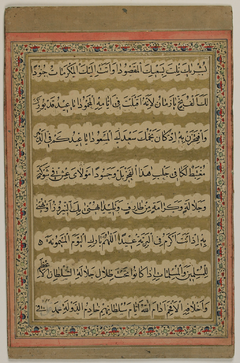
Back Eid-oel-Adha Afrikaans Islamisches Opferfest ALS عيد الأضحى Arabic لعيد لكبير ARY عيد الاضحى ARZ ঈদ-উল-জুহা Assamese Eid al-Adha AST Къурбанкъо AV ईद-उल-जुहा AWA Qurban bayramı Azerbaijani
| Eid al-Adha | |
|---|---|
 Calligraphic fragment dated to 1729–30 displaying blessings for Eid al-Adha in Arabic | |
| Official name | Eid al-Adha |
| Observed by | List
|
| Type | Islamic |
| Significance | Commemoration of Abraham (Ibrahim)'s willingness to sacrifice his son in obedience to a command from God |
| Celebrations | During the Eid al-Adha celebration, Muslims greet each other by saying 'Eid Mubarak', which is Arabic for "Blessed Eid". |
| Observances | Eid prayers, animal slaughter, charity, social gatherings, festive meals, gift-giving |
| Begins | 10 Dhu al-Hijja |
| Ends | 13 Dhu al-Hijja |
| Date | 10 Dhu al-Hijjah |
| 2024 date | 16 June - 20 June (Kyrgyzstan, Uzbekistan)[1] 16 June – 18 June (Saudi Arabia, Kazakhstan, Turkmenistan)[2][3][4] 17 June (Indonesia)[5] 18 June - 20 June (United Kingdom, Brunei, Singapore, Japan, Morocco, Malaysia)[6] |
| 2025 date | 6 June – 10 June [7] |
| Related to | Hajj; Eid al-Fitr |
| Part of a series on |
| Islamic culture |
|---|
| Architecture |
| Art |
| Clothing |
| Holidays |
| Literature |
| Music |
| Theatre |
Eid al-Adha (/ˌiːd əl ˈɑːdə/ EED əl AH-də; Arabic: عيد الأضحى, romanized: ʿĪd al-ʾAḍḥā, IPA: [ˈʕiːd alˈʔadˤħaː]) or the Feast of Sacrifice is the second of the two main holidays celebrated in Islam (the other being Eid al-Fitr). In Islamic tradition, it honours the willingness of Abraham to sacrifice his son as an act of obedience to God's command. Depending on the narrative, either Ishmael or Isaac is referred to with the honorific title "Sacrifice of God".[11] However, before Abraham could sacrifice his son in the name of God, and because of his willingness to do so, God provided him with a lamb to sacrifice in his son's place. In commemoration of this intervention, animals such as lambs are sacrificed. The meat of the sacrificed animal is divided into three portions: one part of the meat is consumed by the family that offers the animal, one portion is for friends and relatives, while the rest of the meat is distributed to the poor and the needy. Sweets and gifts are given, and extended family members typically visit and are welcomed.[12] The day is also sometimes called the "Greater Eid" (Arabic: العيد الكبير, romanized: al-ʿĪd al-Kabīr).[13]
In the Islamic lunar calendar, Eid al-Adha falls on the tenth day of Dhu al-Hijja and lasts for four days. In the international (Gregorian) calendar, the dates vary from year to year, shifting approximately 11 days earlier each year.
- ^ Masalieva, Zhazgul (28 June 2023). "Как отметить Курман айт. Правила, условия и требования праздника". 24.kg. Retrieved 28 June 2023.
- ^ "Islamic Holidays, 2010–2030 (A.H. 1431–1452)". InfoPlease. Archived from the original on 18 December 2019. Retrieved 8 September 2020.
- ^ "Курбан айт - 2023 в Казахстане: какого числа и как праздновать". Tengri News. 26 June 2023. Retrieved 28 June 2023.
- ^ "В Туркменистане 28-29-30 июня будут отмечать Курбан байрам". Turkmen Portal. 27 May 2023. Retrieved 28 June 2023.
- ^ Translation, Office of Assistant to Deputy Cabinet Secretary for State Documents & (12 September 2023). "Gov't Announces National Holidays for 2024". Sekretariat Kabinet Republik Indonesia. Retrieved 28 March 2024.
- ^ "Eid Al Adha 2023 in UK is on June 29". Morocco World News. 19 June 2023. Retrieved 28 June 2023.
- ^ Hughes, David (18 July 2021). "When Eid al-Adha 2021 falls – and how long the festival lasts". inews.co.uk. Retrieved 18 July 2021.
- ^ "The Umm al-Qura Calendar of Saudi Arabia". Archived from the original on 11 June 2011. Retrieved 7 March 2017.
- ^ "First day of Hajj confirmed as Aug. 9". Arab News. 1 August 2019. Archived from the original on 8 August 2019. Retrieved 9 August 2019.
- ^ Bentley, David (9 August 2019). "When is the Day of Arafah 2019 before the Eid al-Adha celebrations?". Birmingham Mail. Archived from the original on 11 September 2016. Retrieved 9 August 2019.
- ^ Firestone, Reuven (January 1990). Journeys in Holy Lands: The Evolution of the Abraham-Ishmael Legends in Islamic Exegesis. SUNY Press. ISBN 978-0-7914-0331-0.
- ^ "Id al-Adha". Oxford Islamic Studies Online. Archived from the original on 10 April 2019. Retrieved 11 July 2020.
- ^ Haigh, Phil (31 July 2020). "What is the story of Eid al-Adha and why is it referred to as Big Eid?". Metro. Retrieved 25 April 2021.
Simply, Eid al-Adha is considered the holier of the two religious holidays and so it is referred to as 'Big Eid' whilst Eid al Fitr can be known as 'Lesser Eid'. Eid al-Kabir means 'Greater Eid' and is used in Yemen, Syria, and North Africa, whilst other translations of 'Large Eid' are used in Pashto, Kashmiri, Urdu and Hindi. This distinction is also known in the Arab world, but by calling 'Bari Eid' bari, this Eid is already disadvantaged. It is the 'other Eid'. 'Bari Eid', or Eid-ul-Azha, has the advantage of having two major rituals, as both have the prayer, but it alone has a sacrifice. 'Bari Eid' brings all Muslims together in celebrating Hajj, which is itself a reminder of the Abrahamic sacrifice, while 'Choti Eid' commemorates solely the end of the fasting of Ramazan.
© MMXXIII Rich X Search. We shall prevail. All rights reserved. Rich X Search